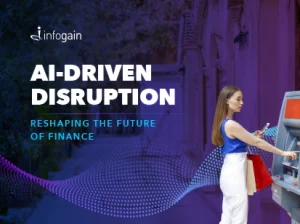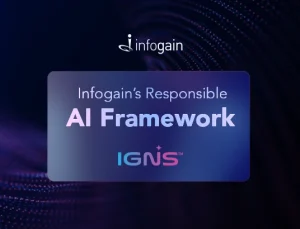- Posted on : September 20, 2017
-
- Industry :
- Type: Blog

The first step in being ALIVE in business is being Agile. At Infogain, ALIVE is our mantra and it stands for: A = Agile, L = Large, I = Innovate, V = Visualize, E = Execute. In my 5-part blog series on ALIVE, I will share with you what I have learned about what being ALIVE means, starting with being Agile – meaning being nimble, responsive, proactive, fast, and not necessarily perfect (don’t overthink it).
It is clear that being agile has revolutionized information technology. Over the past 25-30 years it has greatly increased success rates in IT, improved quality and speed to market, and boosted the motivation and productivity of IT teams. Agile thinking is a radical alternative to command-and-control-style management a lot of us grew up with in our careers. Agile software development has become ubiquitous: Gartner’s Q4 15 “Agile in Enterprise” survey shows on average 41% of development is done using Agile*, and at Infogain we have close to 100 active scrum teams.
But being agile doesn’t have to necessarily be huge initiatives every time, it can be simple steps. For example at Infogain, we created a CEO Connect Group chat on WhatsApp Messenger where we quickly share, respond, and proactively engage without overthinking the process, prepping agendas, meeting notes, etc. In fact just last week, one of our team members was looking for information on our experience implementing loyalty programs at retailers, and within seconds/minutes, he received numerous examples from our offices around the world that he was able to quickly utilize. Using this information, Lave was able to recommend a high value/high quality solution to his client. WhatsApp is an excellent tool that enables agility. It’s a great example of how to be nimble, responsive, proactive, fast and not necessarily perfect!
So what impedes companies from being agile? What I have learned is that companies tend to do the following, which stifles agility: assigning multiple projects with urgent deadlines rather than assigning the highest priority to two or three initiatives, spreading oneself and their best people across too many projects, scheduling too many meetings too often, talking more than listening, and adding too many review layers and controls. All of these are with the best of intentions, we have all done them, but they erode the benefits of what being agile can deliver.
Innovation is what agile is all about. I have found that creating an environment in which agile flourishes, teams churn out innovations faster. I have also learned:
- Being Agile Really Works – compared with traditional management approaches, agile offers a number of major benefits, such as increased team productivity and employee satisfaction. It minimizes the waste inherent in redundant meetings, repetitive planning, excessive documentation, and low-value outputs. Being agile improves customer engagement and satisfaction, brings the most valuable IT consultation of front-end, customer-facing technologies, processes and applications to market faster and actually reduces risk.
- It’s Important to Practice Being Agile – strategy development and resource allocation, cultivating breakthrough innovations, and improving organizational collaboration can all be improved by being agile so practice it. Our senior executives who come together as an agile team and learn to apply the discipline to these activities achieve far-reaching benefits. We own productivity and morale improves. We speak the language of the teams we are empowering. We experience common challenges and learn how to overcome them together. We recognize and stop behaviors that impede agile teams. We learn to simplify and focus work. By practicing being agile, results improve, and subsequently increase confidence and engagement throughout the organization.
- In Order for You to Be Agile, You Need to Lead with Questions, Not Orders – General George S. Patton Jr. famously advised leaders never to tell people how to do things: “Tell them what to do, and they will surprise you with their ingenuity.” Rather than give orders, learn to guide with questions, such as “What do you recommend?” and “How could we test that?” This management style helps teams grow, and it helps organizations evolve from silos battling for power and resources into collaborative cross-functional teams.
I firmly believe that being ALIVE at Infogain starts with being Agile. It leads to greater success, profitable growth and happier employees.






